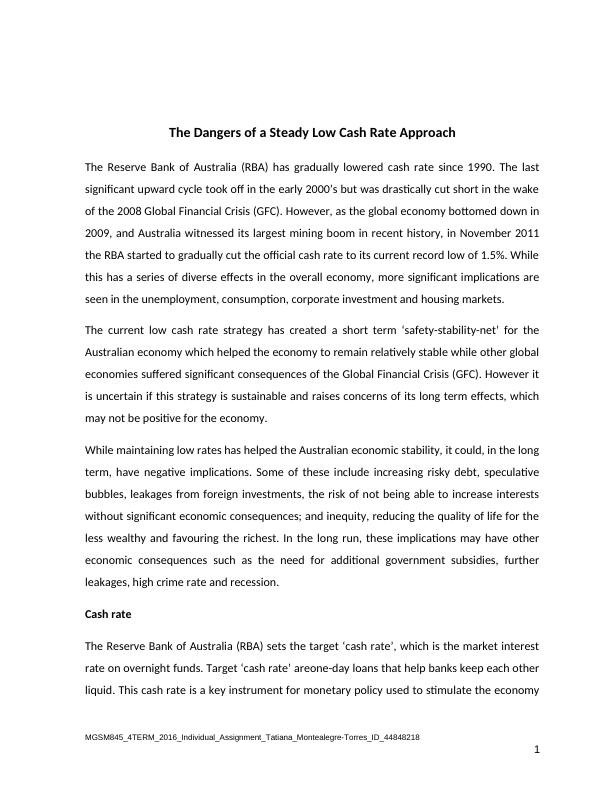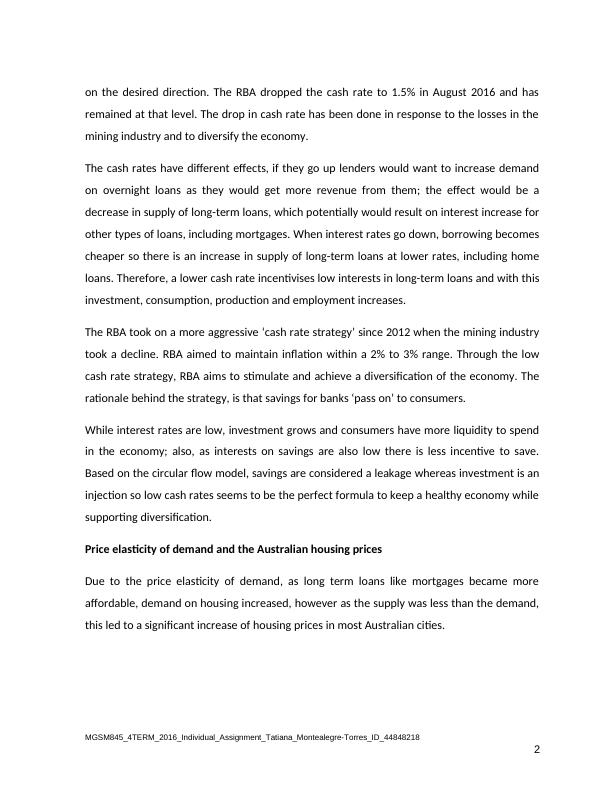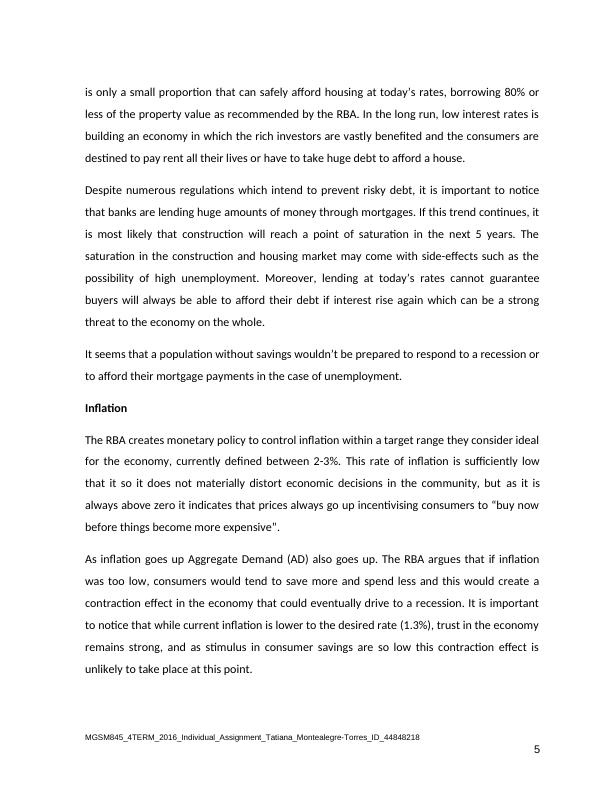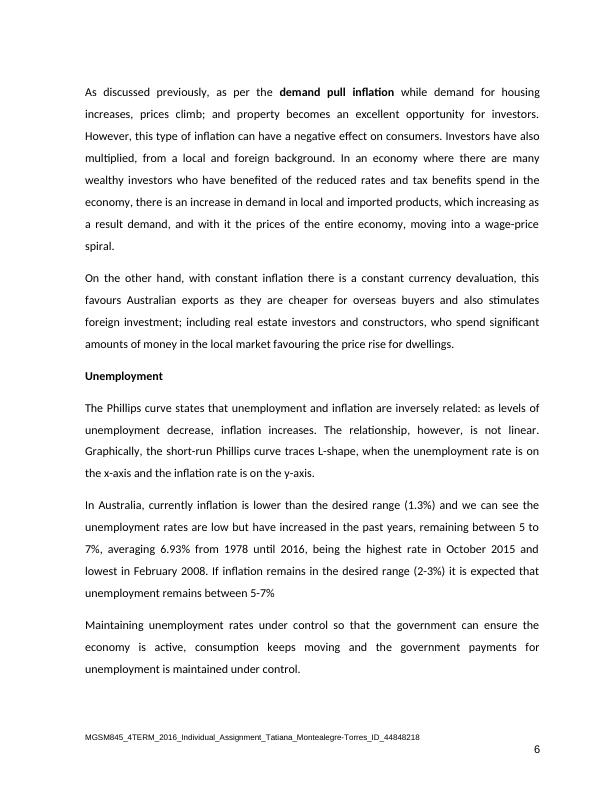The Dangers of a Steady Low Cash Rate Approach
22 Pages4256 Words29 Views
Added on 2020-01-21
The Dangers of a Steady Low Cash Rate Approach
Added on 2020-01-21
ShareRelated Documents
The Dangers of a Steady Low Cash Rate ApproachThe Reserve Bank of Australia (RBA) has gradually lowered cash rate since 1990. The lastsignificant upward cycle took off in the early 2000’s but was drastically cut short in the wakeof the 2008 Global Financial Crisis (GFC). However, as the global economy bottomed down in2009, and Australia witnessed its largest mining boom in recent history, in November 2011the RBA started to gradually cut the official cash rate to its current record low of 1.5%. Whilethis has a series of diverse effects in the overall economy, more significant implications areseen in the unemployment, consumption, corporate investment and housing markets. The current low cash rate strategy has created a short term ‘safety-stability-net’ for theAustralian economy which helped the economy to remain relatively stable while other globaleconomies suffered significant consequences of the Global Financial Crisis (GFC). However itis uncertain if this strategy is sustainable and raises concerns of its long term effects, whichmay not be positive for the economy. While maintaining low rates has helped the Australian economic stability, it could, in the longterm, have negative implications. Some of these include increasing risky debt, speculativebubbles, leakages from foreign investments, the risk of not being able to increase interestswithout significant economic consequences; and inequity, reducing the quality of life for theless wealthy and favouring the richest. In the long run, these implications may have othereconomic consequences such as the need for additional government subsidies, furtherleakages, high crime rate and recession.Cash rateThe Reserve Bank of Australia (RBA) sets the target ‘cash rate’, which is the market interestrate on overnight funds. Target ‘cash rate’ areone-day loans that help banks keep each otherliquid. This cash rate is a key instrument for monetary policy used to stimulate the economyMGSM845_4TERM_2016_Individual_Assignment_Tatiana_Montealegre-Torres_ID_448482181

on the desired direction. The RBA dropped the cash rate to 1.5% in August 2016 and hasremained at that level. The drop in cash rate has been done in response to the losses in themining industry and to diversify the economy.The cash rates have different effects, if they go up lenders would want to increase demandon overnight loans as they would get more revenue from them; the effect would be adecrease in supply of long-term loans, which potentially would result on interest increase forother types of loans, including mortgages. When interest rates go down, borrowing becomescheaper so there is an increase in supply of long-term loans at lower rates, including homeloans. Therefore, a lower cash rate incentivises low interests in long-term loans and with thisinvestment, consumption, production and employment increases.The RBA took on a more aggressive ‘cash rate strategy’ since 2012 when the mining industrytook a decline. RBA aimed to maintain inflation within a 2% to 3% range. Through the lowcash rate strategy, RBA aims to stimulate and achieve a diversification of the economy. Therationale behind the strategy, is that savings for banks ‘pass on’ to consumers. While interest rates are low, investment grows and consumers have more liquidity to spendin the economy; also, as interests on savings are also low there is less incentive to save.Based on the circular flow model, savings are considered a leakage whereas investment is aninjection so low cash rates seems to be the perfect formula to keep a healthy economy whilesupporting diversification.Price elasticity of demand and the Australian housing pricesDue to the price elasticity of demand, as long term loans like mortgages became moreaffordable, demand on housing increased, however as the supply was less than the demand,this led to a significant increase of housing prices in most Australian cities. MGSM845_4TERM_2016_Individual_Assignment_Tatiana_Montealegre-Torres_ID_448482182

The mix of high demand, low debt cost and low supply stimulated growth of residentialconstruction with a rise in real estate investment. As a result, RBA was able to meet its shortterm desired target of increasing employment and consumption in the country.However, this approach has a side effect attached as well. While the rise in housing priceshas been a greatly profitable business for constructors, prices have risen so much thathousing has become unaffordable for the consumers.Hence, individuals who are not in theinvestment game find it difficult to compete against investors when trying to buy a home tolive in.Debt levels on the riseMarion Kohler and Michelle van der Merwe (2015) explained how the housing prices haveincreased consistently with a 5 % average inflation rate in the past decade. The main concernhere is that housing debt-to-income ratio has increased as well (see chart 1 in appendix) andif interest rates go up or tax benefits are reduced the debtors in the population may not beable to afford their mortgages and this could result in a recession. Another consideration is that housing prices continue to rise at a significant rate, faster thanconsumers’ incomes. While benefits and tax exemptions seem to help investors, there arelittle benefits to alleviate home owner’s consumption pattern.Analysts have expressed concerns that the Australian house prices to income ratios areshowing similar trends to those observed in economies prior to speculative bubbles to burst.Current housing prices to income ratio in Australia is close and in some cities even higherthan the levels this ratio presented in the U.S. before its two biggest recessions in 1929 and2007 (see charts 2 and 3 in appendix).The risks of oversupplyIn early November 2016 the RBA announced that despite the housing supply hasn’t reachedequilibrium with demand in major Australian cities yet, if construction continues to grow atMGSM845_4TERM_2016_Individual_Assignment_Tatiana_Montealegre-Torres_ID_448482183

current rates there will be an oversupply in the CBDs of some capital cities in the next 5years. It is important to note also that Australian population growth rate of 1.3 - 1.4% per year(Australian Bureau of Statistics, 2016) is significantly slower than current dwellingconstruction rates of 2.5% (IBIS industry report, 2016) which can possibly reach a point ofsaturation in the next 5 years (see chart 4 in appendix). Another consideration is the type of dwellings that are currently being built. Majority of theinvestment is going towards apartment blocks in the inner city of major CBDs, however, thisis not necessarily the type of housing the Australian consumers are looking for. Youngfamilies prefer houses with backyards in the suburbs rather than crowded apartments.This trend has already been seen in Melbourne where a great percentage (around 20%) ofnew rental apartments are vacant even after a year of completion. Some analysts believethat the government is somehow subsidising these losses with ‘capital gains’ and ‘negativegearing’ and this has become a dangerous game as these benefits can possibly be morepowerful than the rental income.Cash rate effects on savingsWhile low cash rates stimulate debt they also discourage savings. As expenditure goes up,savings go down. Interest return on savings is so small that money remains injected in theeconomy instead of leaking into consumers savings.This, apparently is a significant result of the low cash rate strategy; however it also has adirect effect on housing affordability for consumers and an immediate effect for the oldestpopulation. Low interest rates have made it difficult for consumers to save for a house deposit whichcontinue to increase as the house prices go up. It can be said that low interest rates and itspotential consequences have reduced the possibilities for consumers to own a home. ThereMGSM845_4TERM_2016_Individual_Assignment_Tatiana_Montealegre-Torres_ID_448482184

is only a small proportion that can safely afford housing at today’s rates, borrowing 80% orless of the property value as recommended by the RBA. In the long run, low interest rates isbuilding an economy in which the rich investors are vastly benefited and the consumers aredestined to pay rent all their lives or have to take huge debt to afford a house. Despite numerous regulations which intend to prevent risky debt, it is important to noticethat banks are lending huge amounts of money through mortgages. If this trend continues, itis most likely that construction will reach a point of saturation in the next 5 years. Thesaturation in the construction and housing market may come with side-effects such as thepossibility of high unemployment. Moreover, lending at today’s rates cannot guaranteebuyers will always be able to afford their debt if interest rise again which can be a strongthreat to the economy on the whole.It seems that a population without savings wouldn’t be prepared to respond to a recession orto afford their mortgage payments in the case of unemployment.InflationThe RBA creates monetary policy to control inflation within a target range they consider idealfor the economy, currently defined between 2-3%. This rate of inflation is sufficiently lowthat it so it does not materially distort economic decisions in the community, but as it isalways above zero it indicates that prices always go up incentivising consumers to “buy nowbefore things become more expensive”. As inflation goes up Aggregate Demand (AD) also goes up. The RBA argues that if inflationwas too low, consumers would tend to save more and spend less and this would create acontraction effect in the economy that could eventually drive to a recession. It is importantto notice that while current inflation is lower to the desired rate (1.3%), trust in the economyremains strong, and as stimulus in consumer savings are so low this contraction effect isunlikely to take place at this point.MGSM845_4TERM_2016_Individual_Assignment_Tatiana_Montealegre-Torres_ID_448482185

As discussed previously, as per the demand pull inflation while demand for housingincreases, prices climb; and property becomes an excellent opportunity for investors.However, this type of inflation can have a negative effect on consumers. Investors have alsomultiplied, from a local and foreign background. In an economy where there are manywealthy investors who have benefited of the reduced rates and tax benefits spend in theeconomy, there is an increase in demand in local and imported products, which increasing asa result demand, and with it the prices of the entire economy, moving into a wage-pricespiral.On the other hand, with constant inflation there is a constant currency devaluation, thisfavours Australian exports as they are cheaper for overseas buyers and also stimulatesforeign investment; including real estate investors and constructors, who spend significantamounts of money in the local market favouring the price rise for dwellings.UnemploymentThe Phillips curve states that unemployment and inflation are inversely related: as levels ofunemployment decrease, inflation increases. The relationship, however, is not linear.Graphically, the short-run Phillips curve traces L-shape, when the unemployment rate is onthe x-axis and the inflation rate is on the y-axis.In Australia, currently inflation is lower than the desired range (1.3%) and we can see theunemployment rates are low but have increased in the past years, remaining between 5 to7%, averaging 6.93% from 1978 until 2016, being the highest rate in October 2015 andlowest in February 2008. If inflation remains in the desired range (2-3%) it is expected thatunemployment remains between 5-7%Maintaining unemployment rates under control so that the government can ensure theeconomy is active, consumption keeps moving and the government payments forunemployment is maintained under control. MGSM845_4TERM_2016_Individual_Assignment_Tatiana_Montealegre-Torres_ID_448482186

End of preview
Want to access all the pages? Upload your documents or become a member.
Related Documents
Investment Management Assignment Samplelg...
|19
|4950
|78
Economic principles and decision makinglg...
|15
|4552
|24
Role of Cash Rate in Influencing Economic Growth in Australialg...
|5
|1241
|168
Bank Management | Assignmentlg...
|8
|1269
|34
Report on the speech "Today's Reduction in the Cash Rate" 2022lg...
|15
|4062
|17
Trends in Global Economy: Cash Rate, Inflation, Unemployment and Real GDP Growth Rateslg...
|13
|2974
|257
